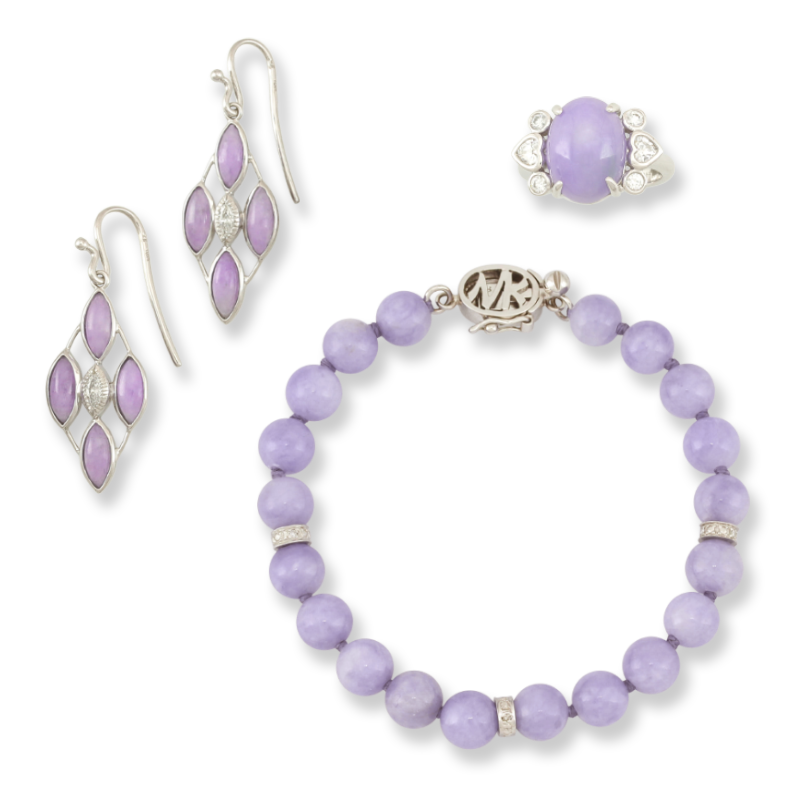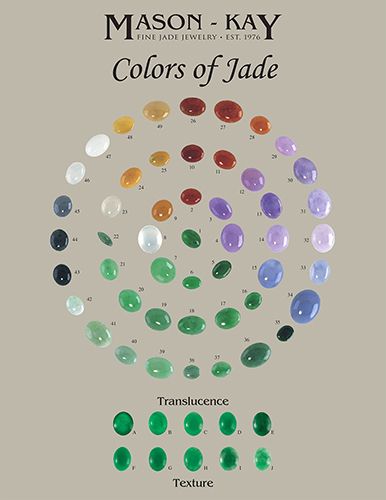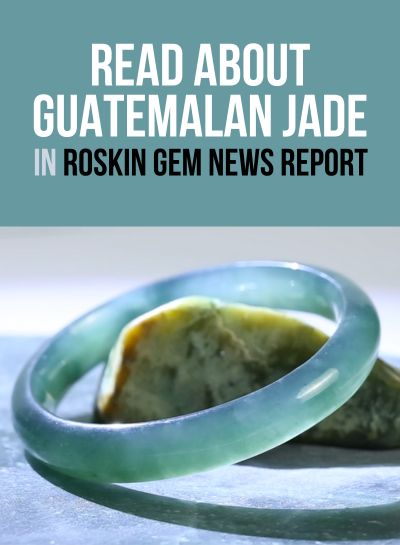
Jade FAQ
What is jade? Great question. The fascination with jade is legendary. It has been used and appreciated by the Chinese since Neolithic times and today we enjoy a Jade Renaissance in the West. However, many misconceptions abound in the marketplace about this amazing gemstone and its characteristics. Here, you will find answers to the most Frequently Asked Questions we receive, including a well-explained jade definition.
Among the oldest of known gemstones, jade has been appreciated at many different levels throughout history: first as an object used in daily life, then in pagan times as an object of ritual. Later, it acquired economic status as an item of barter and wealth, and today it has become a medium of art and personal adornment.
However, the word 'jade' actually refers to two chemically different stones: jadeite, a pyroxene or a silica-bearing mineral, and nephrite, an amphibole, or a ferro-magnesium silicate. Although different, they share many common characteristics.
Nephrite jade, which the Chinese grew to appreciate so deeply, was the form of jade they first encountered in the Neolithic period. It was used for thousands of years and simply referred to as ‘jade’. Another ‘jade’ discovery occurred in the mid-late 1700’s in northern Burma. This jade was found in a greater variety of colors than in the past, and the colors were often much more vivid and translucent. Although the Chinese knew there was a difference, it was not for almost another 100 years until 1863 when French mineralogist Alexis Damour discovered the mineralogical differences between the jades.
When jadeite jade was first introduced into China, it was called Fet'Sui or kingfisher jade because of the brilliance of colors it manifested and to distinguish it from the traditional nephrite form of jade. In time, jadeite eclipsed nephrite in terms of value, and today it is considered gem jade. Today's fine jewelry market uses jadeite jade almost exclusively; nephrite is generally valued for its antiquity, carving excellence and other historical considerations rather than its intrinsic material value. Interestingly enough, both the terms jadeite and nephrite refer to the kidneys because of early beliefs that jade was effective for diseases of the loins.
Apart from its technical aspects, however, there is a magic about the stone that inspired cultures as diverse as the Chinese, the Mayans, even the court of Czarist Russia. Its charms elude precise definition; jade reveals itself in the language of myth and legend.
The Chinese identified "ritual colors" of jade and even spoke of colors "invisible to the eye." In fact, jadeite appears in six basic colors, with many variations. These are green, lavender, red, yellow, white and black. Green, the most important and traditional color, varies through apple green to gray-green and finally black-green.
There is a special magical item called Imperial jade. Although originally said to refer to those jades possessed by the emperor and royal family, Imperial jade today should indicate a stone whose color is a deep, translucent green, and is without visible flaws or color variations. Such stones are truly rare.
Lavender jade can be quite dark - almost deep plum-purple, and in some cases can take on a blue cast. At its other extreme, lavender jade approaches the pink range - though never achieving it - and lightens to a pale lavender-white. Often, lavender jade exhibits a sugary texture.
There are written reports of a blood-orange jade, but most red jade actually ranges from a yellow or beige to a deep russet brown.
Black jade is usually nephrite and, in its finer qualities, is glassy black. Surface flecks are common and difficult to avoid on pieces larger than dime size.
White jade, or "pure" jade, can be found in a chalky, opaque white to a translucent gray-white. A good polish is essential.
The color range for nephrite is not nearly so broad as for jadeite and is usually characterized by a certain dullness of color and waxiness of texture. Old stones (from Turkestan) are sometimes creamy (mutton-fat) white while most modern nephrite ranges from gray-black to an olive green. There is a coal black nephrite, which takes a good polish, and is currently mined in Wyoming and Australia.
It is often asked if there is a blue jade or a pink jade. There is no known blue jadeite, although a deep blue nephrite is claimed. As to pink, most jade reported as pink is, in fact, not jade.
Jade very often exhibits several colors within one piece. Although one pure uniform color is usually best, combinations such as green and lavender, red and green, or white with strong green are very desirable. The Chinese have an extensive list of phrases to identify these combinations and colors: moss-in-snow, chicken-blood, valley-leaf, old mine, spring grass and many others.
Other considerations aside, the hierarchy of color value would be green, lavender, red, yellow, white and black. This is by no means an absolute scale; however, no one would argue with the first two. The finest color of green jade would be close in color to a fine Colombian emerald, but of a darker hue. In fact, the coloring agent, chromium, is the same for jadeite and emerald. As the green becomes lighter or darker than this standard, the value becomes proportionately less. The same can be said of the other colors (even black). The ideal is a strong, vibrant color while successively darker or lighter shades are considered less desirable.
In all cases, except white jade, the degree of translucence enhances the value, while a lack of translucence diminishes the value. Translucence alone, in the absence of body color, is called "water" or "crystal" jade.
In a nutshell, the color and translucence of jade are the result of the chemical impurities present in the rough and the rate at which the jade cooled eons ago during the formation process. For example, green is the result of chromic oxide impurities; lavender comes about from the presence of manganese; red jade occurs as the end product of oxidation from surrounding water or earth; black jade denotes high iron content; white jade is "pure" jade. Of course, jade contains many other impurities that modify and shade these colors (quartz, mica, serpentine, etc.).
In the Orient, jade is considered a living thing that is young, then matures and grows green with age. It was said that some people had the ability to make jade turn green more quickly, and that this was a virtue of their mind and body and soul. Alas, interesting myths notwithstanding, this simply will not happen!
Many people even today believe that in times of good health, one's jade grows richer in color, while trauma or illness will drain the color (and absorb the travail). The wearing of jade close to the body was said to ensure health. Interesting though these thoughts may be, there is no evidence that jade will change color. Quite the contrary, jade is impervious to oils, perfumes and most cold acids. Its color is constant, for better or worse.
Nephrite, although usually thought of as an oriental stone, was also mined and carved in ceremonial fashion by many cultures throughout history. Modern nephrite is mined in many places throughout the world. Taiwan, California, Alaska, British Columbia, Wyoming, New Zealand and Russia are the major sites. It is not a rare stone.
Jade is mined in gross boulder form from mountain sites as well as found in the form of float. Being harder than the material in which it is embedded, it emerges when erosion removes the surrounding, softer stone. Thus it is often found near water sources. Typical pieces can vary from one to two pounds to some that weigh seven to eight tons.
It is said that the earliest jade miners were women who, symbolizing the female or "yin" principle, would be "drawn to" the jade, which was said to be symbolic of the male or "yang" principle. Thus, they would find it more easily in rivers and mountains.
Mining today proceeds much as it did in olden times - it is unscientific at best. The monsoon season stops the whole process for six to nine months of the year and, when the rains clear, the locations of the sites are often forgotten. There is one clear improvement: large boulders are no longer broken up at the mining site in order to bring the smaller, more manageable pieces to market. We can only hazard a guess as to how much fine material this primitive process has destroyed over the years. Jade lapidaries now carefully saw all boulders.
Next to "black diamond", Jade is the toughest of all known stones. This extreme durability (a result of its fibrous crypto-or microcrystalline structure) explains its early use by many cultures as tools for farming and hunting. No other stone appears in such a wide variety of forms: bangles, hololith rings, statuary cups, spoons and scepters. It is jade's unparalleled toughness that accounts for its wide variety of uses, and it is this very toughness that allows for the unmatched delicacy of carving one finds in jade.
What other stone can be carved as a continuous chain from a single piece of material and endure as jewelry or statuary for centuries? Because of its toughness and hardness, jade even appeals to the aural senses, for its is said when "jade is struck, it rings true."
Not only has jade been carved as bells, but its pictogram is thought to have been derived from an early jade bell in the form of three resonant pieces of jade supported by a string and a clapper.
It is this same durability that allows a family to pass on a cherished piece from generation to generation and elevates jade from the realm of an ordinary gemstone to a priceless heirloom.
Whereas most gemstones today are sold and evaluated in terms of their carat weight, jade is sold by the piece. In its finer qualities, it can be among the most expensive stones in the world today. This is in keeping with how the ancients valued jade. It is said that one emperor traded a piece of jade for fifteen cities.
Because of the rarity of fine material today, those items that inherently create waste are cut very infrequently. For example, fine beads, drops or bangles can command astounding prices and are never plentiful in the marketplace.
Modern nephrite, by contrast, is of far less value. Whereas a fine jadeite cabochon can range from several thousand dollars on up, the finest nephrite cabochon rarely exceeds a few hundred dollars. There is no rarity of nephrite, and this is reflected in the price. Antique nephrite carvings have value based on the antiquity of the piece, exclusive of material value alone.
It is because of this vast price differential between jadeite and nephrite that we recommend all appraisals clearly identify the material not merely as jade, but more definitively as nephrite jade or jadeite jade.
In ancient times, a jade boulder was first cut into slabs by means of string embedded with a mixture of pig fat and quartz dust kept constantly wet with water. This process alone could take six months and more for an average size boulder.
Afterwards, a design would be inked in according to the dictates of the material. The uppermost consideration was always the best use of the material. Carving for carving sake was simply not done. Ideally, the carving would be elicited from within the rock rather than created by the carver.
As color changes were encountered, patterns would change to accommodate this within the design. The piece would then be pierced with hollow reed drills, and then the carving accomplished with string and abrasive. The key is the abrasive. One does not carve jade as much as one erodes it, and each carver had his preferred mixture for cutting and polishing.
All polishing was done by hand in many operations with successively finer grades of abrasives. Hand and foot powered arbors were also in common use at that time. Again, the exact form of abrasive used was a trade secret from shop to shop. Polishing was (and is) as important a step as the carving itself. All in all, a master carver could well spend years on a single piece depending on its size and level of intricacy.
It is said that before the advent of power cutting tools, there were no poorly carved jades. The process was simply too laborious and time consuming to allow for errors.
Today, the process is very similar in many respects to the ancient one. Power hand-tools have replaced the reed-and-string drill, carborundum saw-wheels do the work of hand drawn bow-saws, and crushed garnet long ago gave way to corundum and then to carborundum in the nineteenth century.
Modern methods have speeded up the processing of a piece from mine-head to window display. The quality available, in the medium to better pieces, is surprisingly excellent. Some pieces rival the work the late Ch'ing Dynasty at the height of the golden period. Hong Kong, the modern center for jade carving in the world, is teeming with third and fourth generation carvers producing excellent work. Mainland China, once the most prominent carving center, is again buying rough material at the the Burmese auctions, after a long hiatus. It would be fitting for China to regain its prominent position in this art.
As with other precious stones, there have been many attempts to enhance (and even synthesize) jade. Most of these have been detectable by standard and accessible gemological methods until the late 1980's when a new process of treating jadeite came about. This method involves bleaching an already-promising but stained stone, and then impregnating it with a form of plastic. The result is called "B" jade. Currently, infrared spectroscopy is the only test for the detection of polymer in jadeite. Mason-Kay uses an infrared spectrometer to check the authenticity of our product and is one of the few firms in North America to do so.
Red Jade can be heated to increase the redness, but the usual result is a dull brown, and translucence is lost. This process, by the way, is irreversible. Lavender can pose somewhat of a problem; it has a long history of being dyed in a form of "blueberry juice." In some cases, dyed lavender can be spotted right off (in fractured material, dye will accumulate in fissures); but it is not always possible to detect dyed lavender by eye alone. Most dyes fade with time and exposure to sunlight. We recommend buying from a reputable source from which one has recourse.
Common jade fakes include serpentine (also bowenite), carnelian, aventurine quartz, glass, grossularite, idocrase and soapstone. This is not a complete list. Bear in mind that materials known as new jade, Honan jade, Korean jade, metajade and Sinkiang jade are almost never actually jade. The term jade is synonymous with "precious" in Chinese and thus "korean jade" may be no more jade than a "golden sunset" contains gold. Again, know your dealer.



